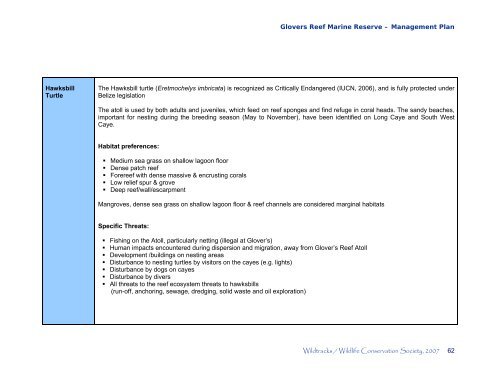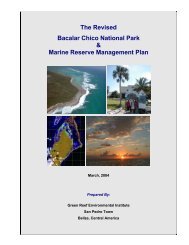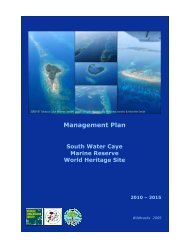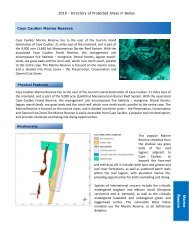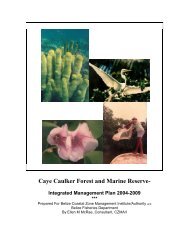Management Plan - Glover's Reef Marine Reserve
Management Plan - Glover's Reef Marine Reserve
Management Plan - Glover's Reef Marine Reserve
You also want an ePaper? Increase the reach of your titles
YUMPU automatically turns print PDFs into web optimized ePapers that Google loves.
Hawksbill<br />
Turtle<br />
Glovers <strong>Reef</strong> <strong>Marine</strong> <strong>Reserve</strong> – <strong>Management</strong> <strong>Plan</strong><br />
The Hawksbill turtle (Eretmochelys imbricata) is recognized as Critically Endangered (IUCN, 2006), and is fully protected under<br />
Belize legislation<br />
The atoll is used by both adults and juveniles, which feed on reef sponges and find refuge in coral heads. The sandy beaches,<br />
important for nesting during the breeding season (May to November), have been identified on Long Caye and South West<br />
Caye.<br />
Habitat preferences:<br />
Medium sea grass on shallow lagoon floor<br />
Dense patch reef<br />
Forereef with dense massive & encrusting corals<br />
Low relief spur & grove<br />
Deep reef/wall/escarpment<br />
Mangroves, dense sea grass on shallow lagoon floor & reef channels are considered marginal habitats<br />
Specific Threats:<br />
Fishing on the Atoll, particularly netting (illegal at Glover’s)<br />
Human impacts encountered during dispersion and migration, away from Glover’s <strong>Reef</strong> Atoll<br />
Development /buildings on nesting areas<br />
Disturbance to nesting turtles by visitors on the cayes (e.g. lights)<br />
Disturbance by dogs on cayes<br />
Disturbance by divers<br />
All threats to the reef ecosystem threats to hawksbills<br />
(run-off, anchoring, sewage, dredging, solid waste and oil exploration)<br />
Wildtracks / Wildlife Conservation Society, 2007 62


